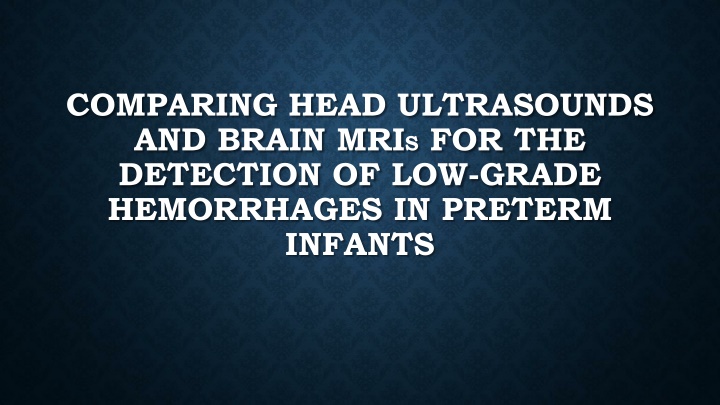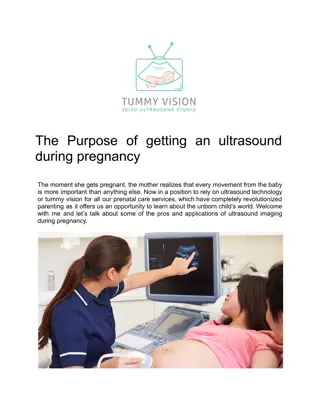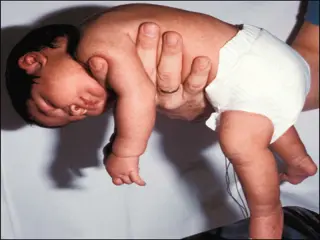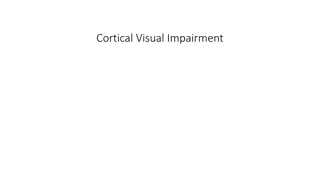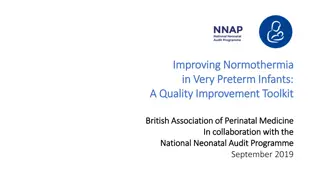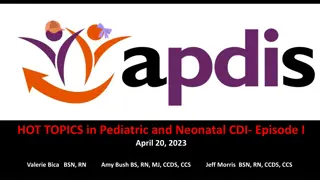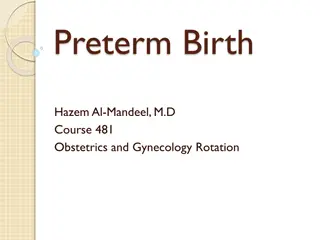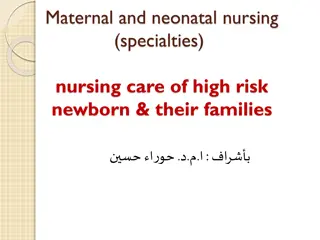Detection of Low-Grade Hemorrhages in Preterm Infants: Ultrasounds vs. MRIs
This study compares the effectiveness of head ultrasounds and brain MRIs in detecting low-grade hemorrhages in preterm infants. It discusses the incidence of intraventricular hemorrhage (IVH) in very low birth weight infants, classification of IVH, risk factors for IVH, outcomes related to IVH grades, and the effects of grades I-II IVH on neurodevelopment in extremely low birth weight infants. The findings highlight the significant impact of IVH on neurologic outcomes and emphasize the importance of accurate imaging and early detection for improved clinical management and long-term outcomes in preterm infants.
Download Presentation

Please find below an Image/Link to download the presentation.
The content on the website is provided AS IS for your information and personal use only. It may not be sold, licensed, or shared on other websites without obtaining consent from the author.If you encounter any issues during the download, it is possible that the publisher has removed the file from their server.
You are allowed to download the files provided on this website for personal or commercial use, subject to the condition that they are used lawfully. All files are the property of their respective owners.
The content on the website is provided AS IS for your information and personal use only. It may not be sold, licensed, or shared on other websites without obtaining consent from the author.
E N D
Presentation Transcript
COMPARING HEAD ULTRASOUNDS AND BRAIN MRIS FOR THE DETECTION OF LOW-GRADE HEMORRHAGES IN PRETERM INFANTS
INCIDENCE OF IVH From 2009 to 2013, the incidence of IVH in VLBW infants in the VON database was 24-26% Table shows incidence in IVH based on birth weights of infants in Vermont Oxford Network for 2013 (including ~55,000 VLBW infants) Inder TE, Perlman MJ, Volpe JJ. (2018). Preterm Intraventricular Hemorrhage/Posthemorrhagic Hydrocephalus. In J J Volpe (Ed.), Volpe s Neurology of the Newborn (pp. 637-698). Philadelphia, PA: Elsevier.
CLASSIFICATION OF IVH Papile IVH classification: Grade I II III IV Type of bleed Blood confined to the germinal matrix Blood in the lateral ventricles without dilation of the ventricles Blood causing enlargement of the lateral ventricles Blood in the brain parenchyma as well as the ventricles
RISK FACTORS FOR IVH Incomplete/ absence of antenatal steroids Vaginal delivery Interhospital transport IVH Prematurity Asphyxia
OUTCOMES High-grade IVH is related to significantly poor neurological outcomes: 70% of those with grade IV IVH had cerebral palsy More recent studies have shown concerns that low-grade IVH may also be related to significantly worse neurodevelopmental outcomes Futagi Y, Toribe Y, Ogawa K, Suzuki Y. Neurodevelopmental Outcome in Children With Intraventricular Hemorrhage. Pediatr Neurol. 2006;34:219-24.
GRADES I-II IVH IN ELBW INFANTS: EFFECTS ON NEURODEVELOPMENT Included a study population of 362 ELBW infants (258 with normal head ultrasounds, 57 with grade I IVH, and 47 with grade II IVH) Patra K. Grades I-II intraventricular hemorrhage in extremely low birth weight infants: Effects on neurodevelopment. 2006;149:169-73.
Major neurologic abnormalities including cerebral palsy, hypertonia, and hypotonia were significantly increased in infants with grade I-II IVH compared to those with normal head ultrasounds.
ADOLESCENTS BORN PREMATURELY WITH ISOLATED GRADE 2 HEMORRHAGE IN THE EARLY 1990S FACE INCREASED RISKS OF LEARNING CHALLENGES Studied preterm infants born 1989-1992 at the age of 16 years who had been enrolled in the Multicenter Randomized Indomethacin IVH Prevention Trial Study included 338 adolescents with birth weights 600-1250g and 102 adolescents born at term as controls Those with grade 2 IVH were more likely to have scores <2 SD below the mean for multiple areas tested (including letter fluency, color-word interference, and rapid naming) than those with no IVH or grade 1 IVH Vohr BR, Allan W, Katz KH, Schneider K, Tucker R, Ment LR. Adolescents born prematurely with isolated grade 2 haemorrhage in the early 1990s face increased risks of learning challenges. Acta Paediatr. 2014;103(10):1066-71.
TIMING OF IVH AND IDENTIFICATION ON MRI Prior intracranial bleeds can be seen on MRI due to blood degradation products. Hemosiderin Hemoglobin IVH Methemoglobin Ferritin Hemosiderin can be identified on MRI up to 10 months after initial hemorrhage with low signal intensity on T2-weighted MRI Gomori JM, Grossman RI. Mechanisms responsible for the MR appearance and evolution of intracranial hemorrhage. Radiographics. 1988;8(3):427-40.
SUSCEPTIBILITY WEIGHTED IMAGING FOR IVH Susceptibility weighted imaging (SWI) is a technique which uses the differences of magnetic susceptibility of different materials SWI allows for the identification of small amounts of blood products which may not be seen on other modalities of MRI With SWI sequences, there is decreased risk of small IVH that occurred early after delivery not being identified on the term-corrected MRI.
Choosing Wisely guidelines published in Pediatrics in 2015 specified 5 items in newborn care that may lead to health care waste. One of the 5 items cited were term-equivalent brain MRIs in preterm infants. The authors cited insufficient evidence that this imaging will improve long-term outcomes
STUDY HYPOTHESIS For neonates born <30 weeks gestation, low- grade IVH may not be detected on head ultrasounds performed at one week of life but can be identified on SWI performed at term- corrected age.
METHODS Retrospective chart review of neonates born <30 weeks gestation between 2011 and 2016 who had both a head ultrasound and term-corrected MRI performed at UF Health Head ultrasounds and MRIs were re-read by a single pediatric neuroradiologist and the grade of IVH was determined per Papile classification Data collected Gestational age Thrombocytopenia within 3 days of head ultrasound Mode of delivery Vitamin K administration Length of stay 1- and 5-minute Apgar scores Inborn/outborn
INCLUSION IN STUDY 99 patients initially identified 94 patients included in final analysis 5 patients excluded 1 did not have an MRI performed until 1 year of age 3 did not have a head ultrasound <14 days of life 1 had an incomplete EMR
PATIENT DEMOGRAPHICS Number of patients by gestational age Gestational ages ranged from 23 to 29 weeks with a mean gestational age of 25.8 weeks 1.8 25 Number of patients 20 44 were delivered via vaginal delivery and 50 delivered via C-section 15 10 74 patients were inborn and 20 were transferred from outside hospitals 5 0 23 weeks 24 weeks 25 weeks 26 weeks Gestational age 27 weeks 28 weeks 29 weeks
DEMOGRAPHICS 47 males and 47 females Apgar Scores were available on 90 patients Median 1 minute Apgar was 4 and median 5 minute Apgar was 6 Thrombocytopenia 14 out of the 94 patients had thrombocytopenia (platelet count<100) identified within 3 days of the head ultrasound
HEAD ULTRASOUNDS Classified by the highest-grade IVH identified on Day 2 to 12 of life (mean age at time of head ultrasound was 6.9 days 1.5) Gestational age in weeks Normal Head Ultrasound Grade I IVH Grade II IVH Grade III IVH Grade IV IVH PVL without IVH 23 weeks 24 weeks 25 weeks 26 weeks 27 weeks 28 weeks 29 weeks Total 2 5 3 3 2 1 0 1 2 3 2 6 6 3 3 9 5 2 2 3 4 0 3 2 3 1 1 2 2 1 3 3 1 2 1 0 0 1 1 0 0 0 2 In all, 16 patients had normal head ultrasounds, 2 had no IVH but had PVL, 23 had grade I IVH, 28 had grade II IVH, 12 had grade III IVH, and 13 had grade IV IVH 16 23 28 12 13
MRI FINDINGS Corrected gestational age at the time of the MRI ranged from 32 to 47 weeks SWI sequences were obtained for 91 of the 94 total patients Gestational age in weeks No bleed Grade I IVH Grade II IVH Grade III IVH Grade IV IVH Cerebellar hemorrhage without IVH Periventricular hemorrhage without IVH 23 24 25 26 27 28 29 2 0 1 1 5 2 2 0 2 3 0 1 1 0 7 3 0 2 0 3 0 2 2 9 2 1 3 3 2 1 1 1 1 0 1 0 0 1 4 0 0 1 0 0 0 1 2 14 9 6 4 7 3 46 Total 13 13
MRI FINDINGS IN NEONATES WITH NORMAL HEAD ULTRASOUNDS AT 1 WEEK OF LIFE 16 patients out of the 94 total had normal head ultrasounds M R I Findings in patients w ith norm al head ultrasounds Of those, MRI findings showed: 3 patients with grade I IVH N orm al M R I 5 patients with grade II IVH G rade I IV H 3 patients with cerebellar hemorrhage G rade II IV H Cerebellar hem orrhage 5 patients without any bleed Total=16
HEAD ULTRASOUND READS OF NEONATES WITH NORMAL MRI 13 patients of the 94 total had normal MRIs. H ead ultrasound read of patients w ith norm al M R Is Head ultrasound reads for these patients showed: Norm al head ultrasound G rade I IVH on ultrasound G rade II IVH on ultrasound 5 with normal head ultrasounds 6 with grade I IVH on head ultrasound 2 with grade II IVH on head ultrasound Total=13
SWI AND T2 SEQUENCES 91 of the 94 patients had SWI sequences obtained. There were 3 patients in whom bleeds were identified on SWI but not on T2 sequences: 2 with a grade I IVH and 1 with a grade 2 IVH
STATISTICAL ANALYSIS Logistic regression performed to show correlation between identification of IVH on head ultrasound and MRI using MRI as the gold standard for identification of IVH. ROC curves for identification of all grades of IVH (A) and for those with no bleed, grade I, or grade II IVH (B) were created. A B This ROC curve shows that head ultrasounds are able to identify all grades of IVH well This shows less of a correlation between head ultrasound and MRI when just neonates with no bleeds, grade I or grade II IVH are identified. AUC=98.3% AUC=69%
WHAT DOES THIS MEAN? In our study, head ultrasounds showed significant correlation with MRI results when all grades of IVH were analyzed. However, the ability of the head ultrasound to predict IVH is decreased when identifying patients with no IVH or low-grade IVH Head ultrasounds were more likely to lead to over-diagnosis of IVH early on, which could lead to significant anxiety/stress for families.
STRENGTHS OF STUDY Patient population included patients over a span of 5 years All imaging obtained at a single center with the same radiology protocols which reduces variability amongst patients Imaging re-read by a single pediatric neuroradiologist
LIMITATIONS OF STUDY Ultrasounds performed by various ultrasound technicians accounting for variability in images obtained Head ultrasounds were not obtained at the same time as the term- corrected MRI Confounding factors such as sepsis, hypotension, cardiac disease, etc were not accounted for.
WHY IS IDENTIFICATION OF LOW-GRADE BLEEDS IMPORTANT Having appropriate developmental followup Counseling families Evidence of patients with low grade IVH having decreased Bayley scores at 1 year of age and impacting learning in adolescence.
FUTURE DIRECTIONS Correlating the data obtained in this study with Bayley scores from follow up clinic to investigate the correlation between SWI sequences and developmental outcomes
ACKNOWLEDGMENTS Michael Weiss, MD Dhanashree Rajderkar, MD Livia Sura, MPH Nicolay Bliznyuk, PhD Mehmet Albayram, MD Suman Ghosh, MD
REFERENCES Inder TE, Perlman MJ, Volpe JJ. (2018). Preterm Intraventricular Hemorrhage/Posthemorrhagic Hydrocephalus. In J J Volpe (Ed.), Volpe s Neurology of the Newborn (pp. 637-698). Philadelphia, PA: Elsevier. Szpecht D, Szymankiewicz M, Nowak I, Gadzinowski J. Intraventricular hemorrhage in neonates born before 32 weeks of gestation-retrospective analysis of risk factors. Childs Nerv Syst. 2016;32:1399-404. https://doi.org/10.1007/s00381-016-3127-x Ment LR, Oh W, Ehrenkranz RA, Philip AG, Duncan CC, Makuch RW. Antenatal steroids, delivery mode, and intraventricular hemorrhage in preterm infants. Am J Obstet Gynecol. 1995;172(3):795-800. https://doi.org/10.1016/0002-9378(95)90001-2 Futagi Y, Toribe Y, Ogawa K, Suzuki Y. Neurodevelopmental Outcome in Children With Intraventricular Hemorrhage. Pediatr Neurol. 2006;34:219-24. Patra K. Grades I-II intraventricular hemorrhage in extremely low birth weight infants: Effects on neurodevelopment. 2006;149:169-73. Vohr BR, Allan W, Katz KH, Schneider K, Tucker R, Ment LR. Adolescents born prematurely with isolated grade 2 haemorrhage in the early 1990s face increased risks of learning challenges. Acta Paediatr. 2014;103(10):1066-71. Gomori JM, Grossman RI. Mechanisms responsible for the MR appearance and evolution of intracranial hemorrhage. Radiographics. 1988;8(3):427-40. Ho T, Dukhovny D, Zupancic JA, Goldmann DA, Horbar JD, Pursley DM. Choosing Wisely in Newborn Medicine: Five Opportunities to Increase Value. Pediatrics. 2015;136(2):e482-9. Maalouf EF, Duggan PJ, Counsell SJ, Rutherford MA, Cowan F, Azzopardi D, et al. Comparison of findings on cranial ultrasound and magnetic resonance imaging in preterm infants. Pediatrics. 2001;107(4):719-27. Neubauer V, Djurdjevic T, Griesmaier E, Biermayr M, Gizewski ER, Kiechl-Kohlendorfer U. Routine Magnetic Resonance Imaging at Term-Equivalent Age Detects Brain Injury in 25% of a Contemporary Cohort of Very Preterm Infants. PLoS ONE. 2017.
COMPARISON OF FINDINGS ON CRANIAL ULTRASOUND AND MRI IN PRETERM INFANTS A study of 32 infants with a median gestational age of 27 weeks compared head ultrasounds and MRIs performed on the same day of life. This study showed that HUS had sensitivity of 69% and specificity of 90%. The bleeds not detected on HUS in this study were all small bleeds in the posterior horns. SWI sequences were not obtained on any patients in this study. Maalouf EF, Duggan PJ, Counsell SJ, Rutherford MA, Cowan F, Azzopardi D, et al. Comparison of findings on cranial ultrasound and magnetic resonance imaging in preterm infants. Pediatrics. 2001;107(4):719-27.
ROUTINE MRI AT TERM-EQUIVALENT AGE DETECTS BRAIN INJURY IN 25% OF A CONTEMPORARY COHORT OF VERY PRETERM INFANTS This study included 300 neonates born <32 weeks with term-corrected MRIs. Showed that IVH was diagnosed by head ultrasound in the majority of cases- a total of 48 patients had IVH and 46 were identified on HUS. SWI sequences were performed on 181/300 patients (based on year of admission). Neubauer V, Djurdjevic T, Griesmaier E, Biermayr M, Gizewski ER, Kiechl-Kohlendorfer U. Routine Magnetic Resonance Imaging at Term-Equivalent Age Detects Brain Injury in 25% of a Contemporary Cohort of Very Preterm Infants. PLoS ONE. 2017.
